Last year's early adopters of Staking are now earning or losing?
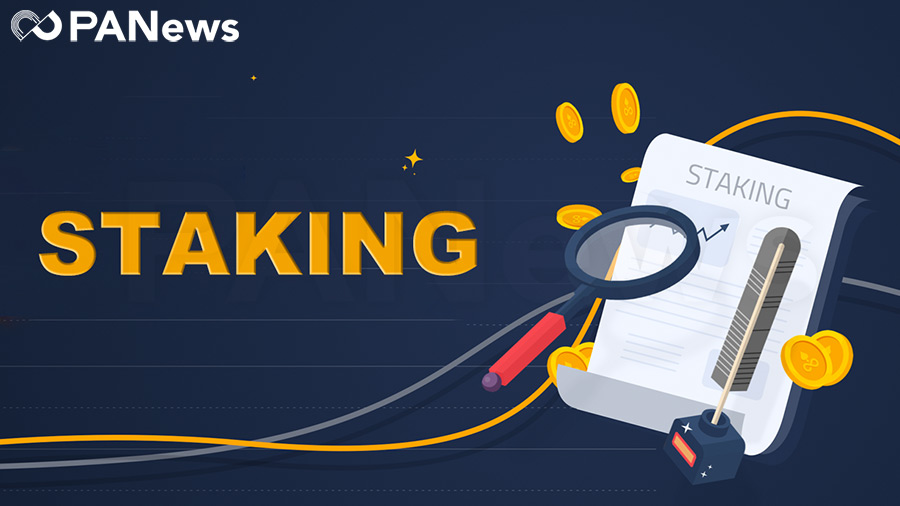
Analyst | Carol Editor | Bi Tongtong | PANews
At this time last year, Staking was all the rage, and many players "run" to enter. In the past year, as more and more PoS public chains went online, the Staking market is becoming wider and wider. There are even voices in the market that this year may be the year of Staking. Unlike the PoW mining market giants, which have high asset thresholds, Staking is regarded as a “new blue ocean” by mining pools, node service providers, and wallets. It is also an excellent opportunity to share mining dividends. They have hit "combination punches" with high returns and low risks to attract users. Then, the users who took early adopters of Staking last year, have been calculated according to fiat currency to make or lose?

- Bitcoin's short-term bulls are weak, the daily line still has the risk of retracement
- Bank of Japan: Whether to issue central bank digital currency is an important issue
- Getting started with blockchain | New advances in quantum computers, is the wallet safe?
Average return has picked up but pledge rate continues to decline
According to Staking Rewards statistics, as of March 3, a total of 85 types of assets have been opened for staking. The total market value of these assets is US $ 15.007 billion, and the total amount of pledged tokens is US $ 9.962 billion. About 8.03%.

The median income of PAData on July 25, 2019 was about 7.03% (refer to "Staking Make Money: The average annualized rate is about 7% and there are many new ways to play"), and Staking has just risen on April 4, 2019. , The median income is about 10.05% (refer to "Stand on the Staking vent, who is the new Bitmain?"). At present, the average annualized return of the currency standard in the market is still lower than when Staking just appeared, but it has picked up from half a year ago.
Among them, the highest-earning COTI, SNX, CSDT, LPT, ENQ, and PRV currency-based annualized returns all exceeded 50%, and the lowest-earning LSK, ARDR, and EDG currency-based annualized returns did not exceed 1%. It can be seen that the staking income of different assets is relatively scattered. In addition, the annualized returns of the currency standard of the established public chains NEO, VET and XLM do not exceed 2%, and TRX and EOS are only 3.73% and 3.10%.
Li Chen, CEO of HashQuark, a PoS mining pool under HashKey Group in Hong Kong, said in an exclusive interview with PANews that there may be problems with too high or too low returns. From observation, it is often small currencies that have high returns, and most of the well-known public chains that were established earlier, run longer, and have a higher market volume are mostly below average.
Unlike the fluctuations in income, the average pledge rate of Staking is currently lower than when it first emerged and lower than half a year ago. At present, the average pledge rate in the market is about 39.74%, and the median is about 37.45%. The median pledge rate on July 25, 2019 was approximately 42.36%, and on April 4, 2019, it was approximately 46%.
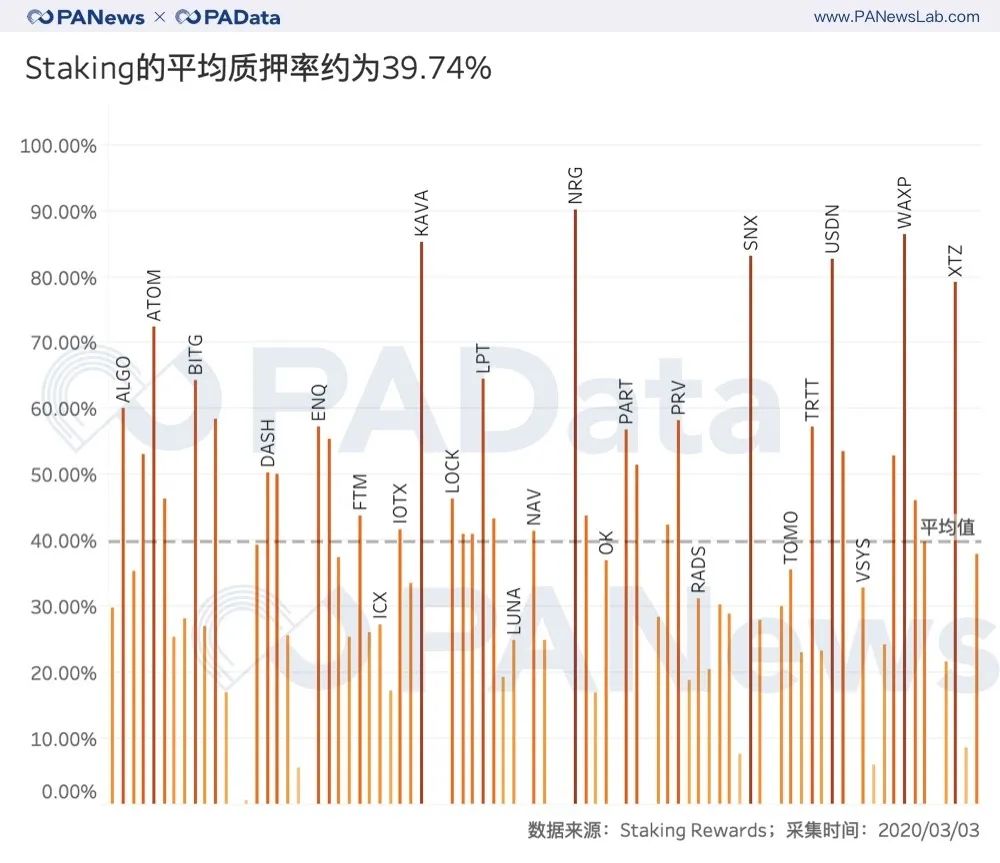
NRG, WAXP, KAVA, SNX, and USDN are the five assets with the highest pledge rates, all of which exceed 80%, and ATOM and ALGO, which have received much attention, also have higher pledge rates, exceeding 72% and 60%, respectively. XZC, SMART, WABI, EDG and COTI are the five assets with the lowest pledge rates, all less than 10%.
According to the calculation formula of Staking's expected annualized return ≈ inflation rate / pledge rate, the return is closely related to the pledge rate, so it is very important for investors to observe the daily pledge rate.
In addition, out of 85 types of assets, only 11 types of assets take into account the inflation rate, Staking instead reduced (including unchanged) the share of the total amount of tokens in circulation. The remaining 74 types of assets have increased the share of total currency holders' holdings in total circulation after staking. The average adjusted return of these assets is about 8.86%.
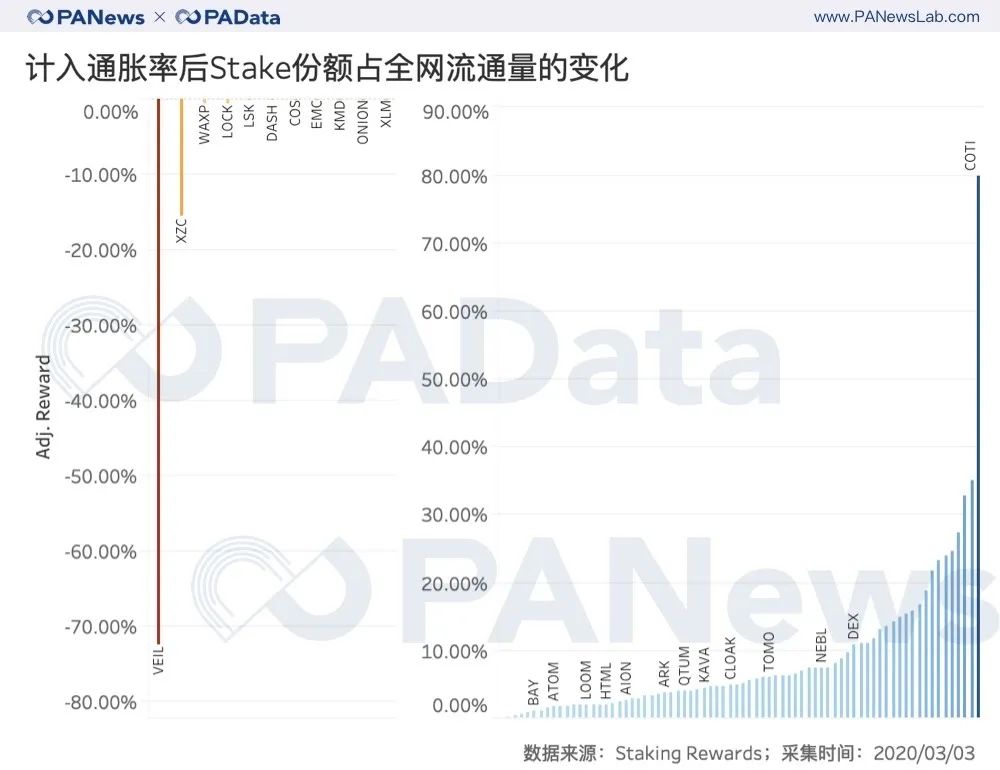

Staking's expected fiat annualized return is about 37%
At present, the asset with the highest total value of pledged tokens on the market is EOS, which reached approximately US $ 2.049 billion, followed by XTZ, which reached US $ 1.831 billion. Prior to this, XTZ once surpassed EOS and became the "boss" of the market value of pledged tokens. The market value of the pledged tokens of these two assets has exceeded one-third of the total value of all pledged markets. In addition, the market value of pledged tokens of ATOM, DASH, TRX, XEM, SNX, and DCR also exceeded US $ 100 million.

What is the annualized return of the fiat standard of these most popular staking assets? Did the early adopters of Staking make money today?
PAData converts the number of staking assets according to the expected annualized return of the currency standard of these assets, and then combines the currency price of one year ago (take the opening price on March 1, 2019. The earliest day's opening price) and the current currency price (taken on the closing price on March 3, 2020) estimate the annual fiat currency returns of the 15 assets with the highest total Staking value.
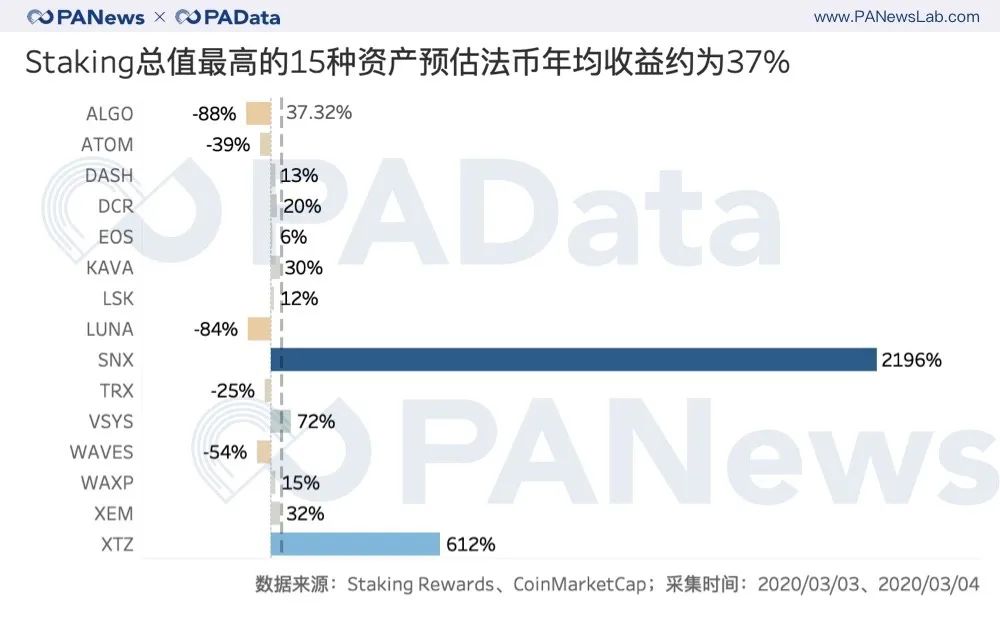
According to statistics, SNX is the asset with the highest expected annual return of the fiat currency standard among 15 types of assets, reaching 2195%, followed by XTZ, which reaches 612%. The expected return of the fiat currency of VSYS is also relatively high, reaching 72%, and the remaining positive returns The return on assets is about 10% -30%. In addition, TRX, ATOM, WAVES, LUNA, and ALGO have negative expected fiat returns, and ALGO and LUNA, which have the lowest returns, are at a loss of about 80%. Excluding the extreme impact of SNX, the average expected annualized return of fiat currencies for 14 assets is about 37.32%.
In fact, in essence, as an investment method, Staking can only change the number of coins held. Even if the compound interest of Staking currency standard income is counted, its impact is small, and the price of the currency is the most important factor affecting mining. Factors, whether it is PoW mining or PoS mining.
SNX, which expects the highest return on fiat currency, holds 1274.82% of its currency holdings and 66.97% of its currency standard returns. Both dimensions are positive performance, so Staking has greatly enhanced the gain effect. Similarly, there are DASH, DCR, KAVA, VSYS, XEM and XTZ.
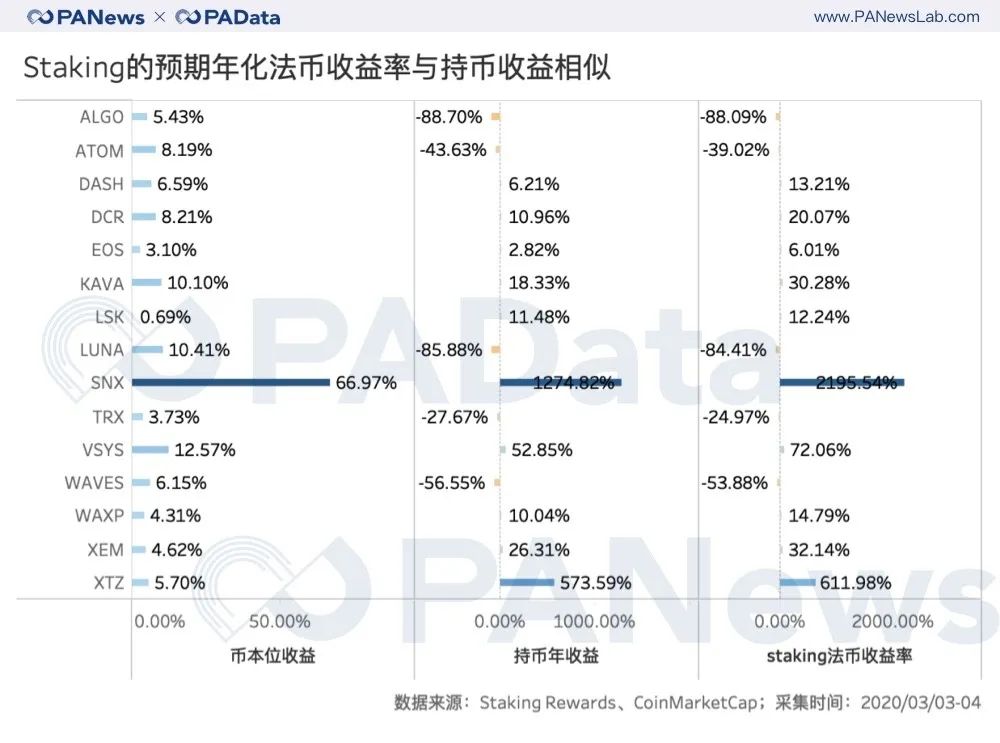
And if the return on currency holdings is negative, that is, the currency price is in a downward trend from the perspective of the whole year, then the expected legal currency return on Staking is also negative, and the losses are comparable, which means that Staking can only play a very limited role in reducing losses. For example, for LUNA, the return on holding currency is -85.88%. Even if the currency standard of Staking benefits from 10.41%, the final return on legal currency is still -84.41%. Similar situations include ATOM, ALGO, and WAVES.
If you put the expected annual return of fiat currency into the annual range of holding currency, you can observe the risk level of Staking, that is, whether Staking is more likely to obtain high or low returns than holding currency.
According to statistics, except that the expected returns of fiat currencies of XTZ and SNX are closer to the highest returns of holding currencies, the yields of fiat currencies of other assets are closer to the minimum returns.
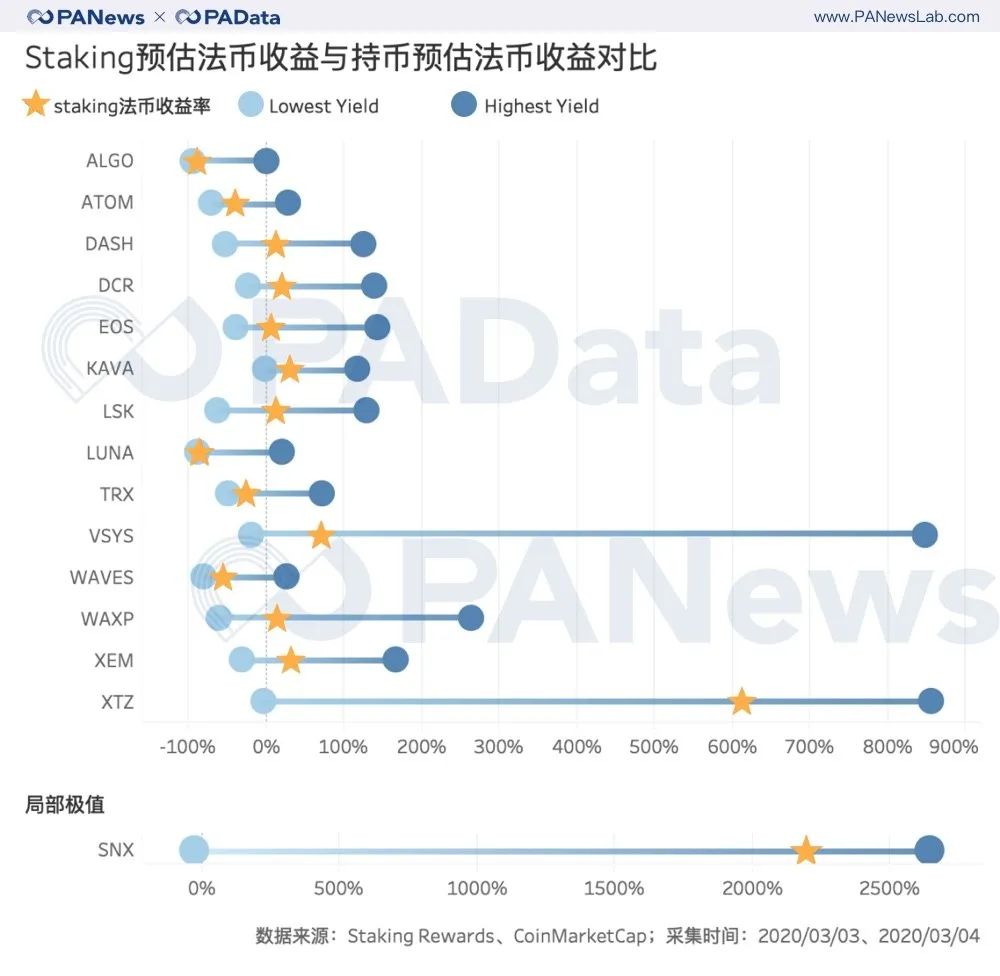
Although most assets are more than 70% away from the highest holding income, except that the staking income of ALGO and LUNA is only less than 7% higher than the minimum holding income, the staking income of the remaining 11 assets is higher than the minimum return More than 25% higher. This means that, overall, Staking's level of return risk is more robust than holding coins.
We will continue to update Blocking; if you have any questions or suggestions, please contact us!
Was this article helpful?
93 out of 132 found this helpful
Related articles
- HD Wallet Soul Check! Which wallets can stand the test?
- Hardcore PK gold: Bitcoin and gold, who is the better hedge asset? (on)
- Ethereum developers: ProgPoW is more ASIC friendly than current algorithms
- Hardcore PK Gold: What is the history of abandoned gold, what can it inspire Bitcoin? (under)
- Repeated mistakes | Can cryptocurrency prevent the next recession?
- FCoin releases latest announcement: funding gap of approximately 90 million USDT
- Vitalik Buterin: Ethereum 2.0 Phase 0 is expected to start this summer, and PoS will eventually become a reality






